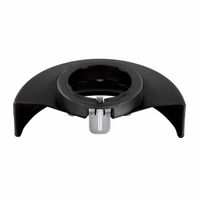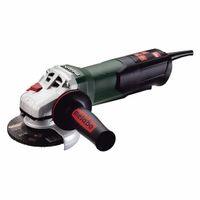Call +(254) 703 030 000 / 751 483 999 / 721 704 777
- Home
- Tools
- Power Tools
- Grinders Cut Off Tools
- Angle Grinders
.....Read More
Frequently Asked Questions
What is an angle grinder used for?
An angle grinder is a versatile power tool used for a variety of tasks in metalworking, construction, and other industries. It is primarily used for cutting, grinding, and polishing materials. Equipped with a rotating abrasive disc, it can cut through metal, concrete, tile, and stone. In metalworking, angle grinders are used to remove excess material, smooth out welds, and cut metal bars, rods, and sheets. They are also employed in the preparation of surfaces for welding or painting by removing rust, paint, and other coatings.
In construction, angle grinders are used to cut and shape bricks, tiles, and stones, making them essential for masonry work. They can also be used to cut rebar and other metal reinforcements in concrete structures. For woodworking, angle grinders can be fitted with special attachments to sand and shape wood, although they are less commonly used for this purpose compared to other tools.
Angle grinders are also used for polishing and finishing surfaces. By attaching a polishing pad or wheel, they can be used to polish metal surfaces to a high shine or to smooth out rough edges. Additionally, they are used in automotive repair and restoration to remove old paint and rust from car bodies.
Safety is crucial when using an angle grinder, as the high-speed rotation of the disc can pose risks. Proper protective gear, such as gloves, goggles, and ear protection, should always be worn. The tool should be handled with care to prevent accidents, and users should be trained in its operation to ensure safe and effective use.
How do you choose the right angle grinder?
To choose the right angle grinder, consider the following factors:
1. **Power Source**: Decide between corded and cordless models. Corded grinders offer consistent power, while cordless ones provide portability and convenience.
2. **Disc Size**: Common sizes are 4.5, 5, 6, 7, and 9 inches. Smaller discs are suitable for precision work, while larger discs are better for heavy-duty tasks.
3. **Motor Power**: Measured in amps (corded) or volts (cordless), higher power is needed for tougher materials. For general use, 5-9 amps or 18-20 volts is sufficient.
4. **Speed**: Measured in RPM, higher speeds are better for cutting, while lower speeds are suitable for grinding. Variable speed grinders offer more versatility.
5. **Ergonomics**: Look for a comfortable grip, adjustable side handles, and a manageable weight to reduce fatigue during extended use.
6. **Safety Features**: Consider models with safety guards, anti-kickback features, and paddle switches to enhance user safety.
7. **Durability**: Choose a grinder with a robust build, preferably with metal gear housing, to withstand tough conditions.
8. **Brand and Warranty**: Opt for reputable brands known for quality and reliability, and check for a good warranty to ensure long-term support.
9. **Attachments and Accessories**: Ensure compatibility with various discs and attachments for different tasks like cutting, grinding, and polishing.
10. **Budget**: Balance between cost and features. Higher-end models offer more power and features but at a higher price.
By evaluating these factors, you can select an angle grinder that best suits your specific needs and tasks.
What safety precautions should be taken when using an angle grinder?
1. **Personal Protective Equipment (PPE):** Wear safety goggles or a face shield to protect against flying debris. Use ear protection to guard against noise. Wear gloves to protect your hands and a dust mask if working with materials that produce dust.
2. **Inspect the Grinder:** Check the angle grinder for any damage or defects before use. Ensure the guard is in place and secure. Verify that the disc is appropriate for the material and is not cracked or damaged.
3. **Secure the Workpiece:** Ensure the material being worked on is securely clamped or held in place to prevent movement during operation.
4. **Correct Disc Installation:** Make sure the disc is properly mounted and tightened. Use the correct disc for the task and material.
5. **Safe Environment:** Work in a well-ventilated area to avoid inhaling dust and fumes. Keep the workspace clean and free of clutter to prevent tripping hazards.
6. **Proper Handling:** Hold the grinder with both hands for better control. Maintain a firm grip and be aware of the kickback.
7. **Avoid Loose Clothing:** Wear fitted clothing and secure long hair to prevent entanglement with the moving parts.
8. **Power Source Safety:** Ensure the power cord is in good condition and positioned away from the grinding area to prevent damage. Use a Residual Current Device (RCD) for added electrical safety.
9. **Start and Stop Procedures:** Allow the grinder to reach full speed before applying it to the workpiece. Turn off the grinder and wait for the disc to stop spinning before setting it down.
10. **Stay Alert:** Be aware of your surroundings and maintain focus on the task to prevent accidents.
11. **Emergency Preparedness:** Have a first aid kit and fire extinguisher nearby in case of accidents or emergencies.
What is the difference between a corded and cordless angle grinder?
A corded angle grinder is powered by electricity through a power cord connected to an outlet. It offers consistent power output, making it suitable for heavy-duty tasks and prolonged use without the need for recharging. Corded models typically have higher power ratings, allowing them to handle tougher materials and larger projects. However, their mobility is limited by the length of the power cord, and they require access to an electrical outlet, which can be restrictive in remote or outdoor locations.
In contrast, a cordless angle grinder is powered by a rechargeable battery, providing greater mobility and convenience, especially in areas without easy access to electricity. Cordless models are ideal for quick jobs and tasks in hard-to-reach places. They offer the advantage of portability, allowing users to move freely without being tethered to a power source. However, they generally have less power compared to corded models and are limited by battery life, requiring periodic recharging or battery swaps. Cordless grinders are often lighter, enhancing ease of use, but may not be suitable for extended heavy-duty applications due to their power and runtime limitations.
In summary, the choice between corded and cordless angle grinders depends on the specific needs of the user. Corded grinders are better for continuous, high-power tasks, while cordless grinders offer flexibility and convenience for lighter, more mobile applications.
How do you change the disc on an angle grinder?
1. **Safety First**: Ensure the angle grinder is unplugged from the power source or the battery is removed to prevent accidental start-up.
2. **Position the Grinder**: Place the angle grinder on a stable surface with the disc facing upwards.
3. **Locate the Spindle Lock**: Find the spindle lock button, usually located on the top of the grinder near the disc. Press and hold this button to lock the spindle in place.
4. **Remove the Old Disc**:
- Use a wrench or the tool provided with the grinder to turn the flange nut counterclockwise. This nut holds the disc in place.
- If the disc is stuck, gently tap the wrench with a mallet to loosen it.
- Once the nut is loose, remove it along with the old disc.
5. **Inspect the Flanges**: Check the inner and outer flanges for any damage or wear. Clean them if necessary to ensure a secure fit for the new disc.
6. **Install the New Disc**:
- Place the new disc onto the spindle, ensuring it is seated correctly.
- Position the outer flange over the disc.
- Hand-tighten the flange nut onto the spindle.
7. **Secure the Disc**: Use the wrench to tighten the flange nut while holding the spindle lock button. Ensure the disc is firmly secured but avoid over-tightening, which can damage the disc or the grinder.
8. **Final Check**: Release the spindle lock and spin the disc by hand to ensure it rotates freely without wobbling.
9. **Reconnect Power**: Plug the grinder back in or reattach the battery.
10. **Test Run**: Briefly power on the grinder to ensure the disc is installed correctly and operates smoothly.
What size angle grinder should I use?
The size of the angle grinder you should use depends on the specific task you are undertaking. Here are some general guidelines:
1. **4.5-inch Angle Grinder**: This is the most common size and is ideal for most DIY projects and small-scale tasks. It is suitable for cutting, grinding, and polishing metal, tile, and wood. Its compact size makes it easy to handle and maneuver, especially in tight spaces.
2. **5-inch Angle Grinder**: Slightly larger than the 4.5-inch, this size offers a bit more power and cutting depth. It is suitable for similar tasks as the 4.5-inch but can handle slightly thicker materials.
3. **7-inch Angle Grinder**: This size is more powerful and is used for larger projects. It is suitable for cutting through thicker metal and concrete. It is often used in construction and industrial settings due to its ability to handle heavy-duty tasks.
4. **9-inch Angle Grinder**: The largest common size, it is used for the most demanding jobs. It is ideal for cutting large pieces of metal, concrete, and masonry. Due to its size and power, it requires more skill to handle safely.
Consider the following factors when choosing the size:
- **Material**: Thicker and harder materials require larger grinders.
- **Precision**: Smaller grinders offer more control for detailed work.
- **Portability**: Smaller grinders are easier to transport and use in confined spaces.
- **Power Source**: Larger grinders often require more power, so ensure your power supply can handle it.
Ultimately, choose the size that best matches the demands of your project while considering your comfort and skill level.
How do you maintain an angle grinder?
To maintain an angle grinder, follow these steps:
1. **Regular Cleaning**: After each use, clean the grinder to remove dust and debris. Use a brush or compressed air to clean the vents and motor housing.
2. **Inspect the Disc**: Regularly check the grinding disc for wear and tear. Replace it if it shows signs of damage or excessive wear to prevent accidents.
3. **Check the Guard**: Ensure the safety guard is in place and not damaged. It should be adjusted to deflect sparks and debris away from you.
4. **Examine the Power Cord**: Inspect the power cord for cuts or frays. Replace it if damaged to avoid electrical hazards.
5. **Lubricate Moving Parts**: Periodically lubricate the moving parts, such as the spindle and bearings, with appropriate oil to ensure smooth operation.
6. **Tighten Loose Parts**: Check and tighten any loose screws, nuts, or bolts to ensure the grinder operates safely and efficiently.
7. **Test the Switch**: Ensure the on/off switch works properly. If it sticks or malfunctions, repair or replace it to maintain control over the tool.
8. **Check Carbon Brushes**: Inspect the carbon brushes for wear. Replace them if they are worn down to maintain motor efficiency.
9. **Store Properly**: Store the angle grinder in a dry, dust-free environment. Use a case or cover to protect it from moisture and dirt.
10. **Follow Manufacturer’s Guidelines**: Adhere to the maintenance schedule and guidelines provided in the user manual for specific care instructions.
By following these steps, you can ensure the longevity and safe operation of your angle grinder.


